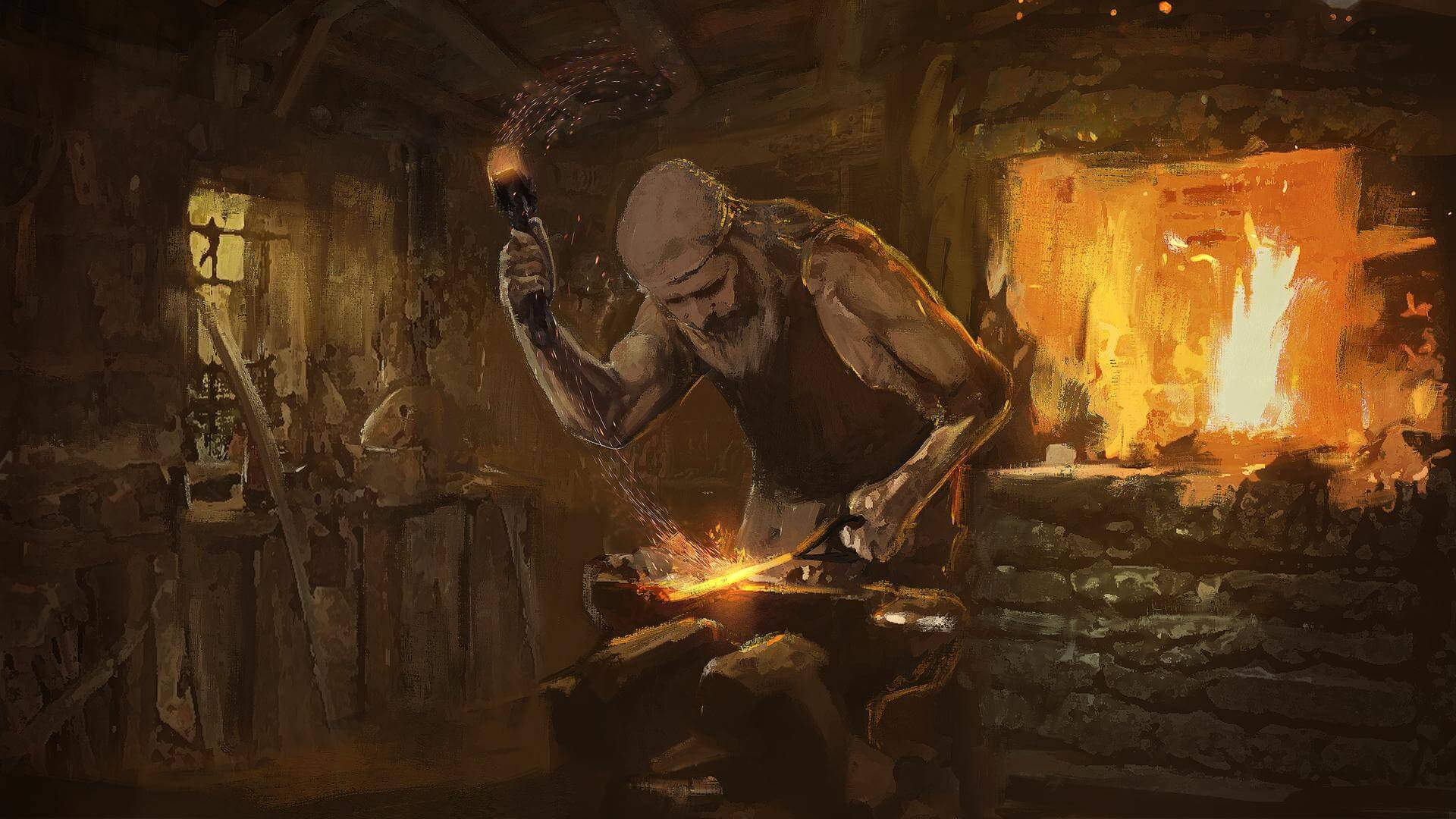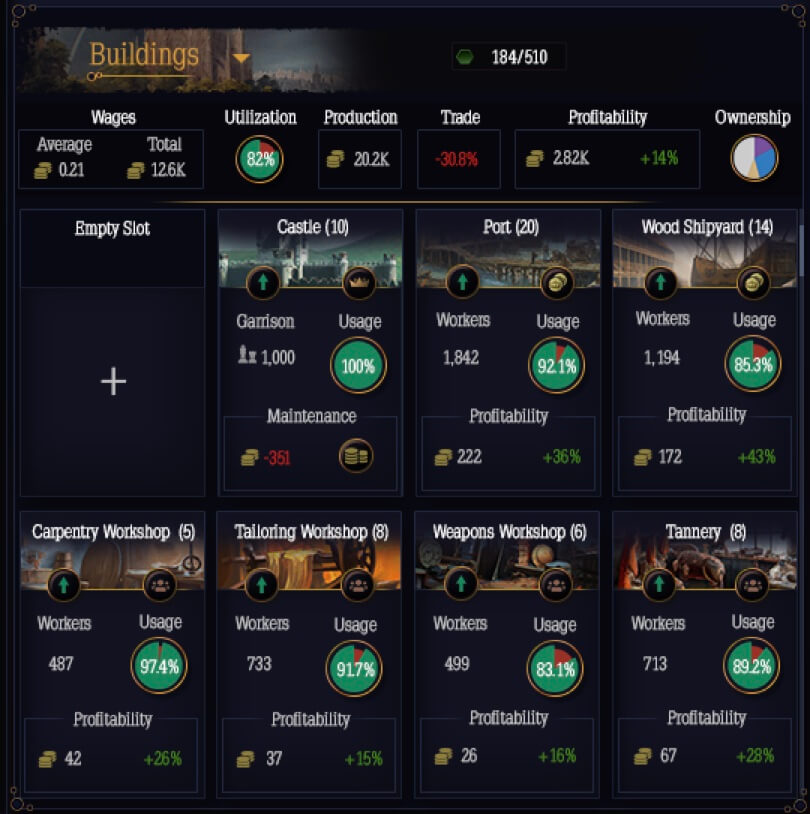Dev Diary #13: Production
15:24, 6 Aug 2022

Hello and welcome to the 13th development diary of Grey Eminence!
With the summer holidays out of the way, we felt that now is a good time to proceed with the series of dev diaries dedicated to the economy, starting with production. The economy is one of Grey Eminence’s strongest suits and we’ve dedicated a large part of the game’s performance budget to it. While the majority of the system will run on its own most of the time, you can interact with the simulation as much (or as little) as you want - in line with our optional complexity design philosophy.
Let’s start with a high-level overview of the production process. The entirety of the production system happens through buildings, where each building has an owner, employs workers, produces goods and hopefully earns a profit at the end of the day.
Buildings
All buildings, whether they represent industry or non-commercial property (like castles, city halls, etc.), come in discrete units. This is an abstract and relative concept, but we’ve tried to balance things in such a way that one unit is very roughly equal to the amount of property needed to employ 100 people. So, for example, a size 1 wheat farm is a farm of such a size that it would need 100 workers to be cultivated at capacity.
As a consequence of making building size a relative concept, different buildings require different amounts of land to be built. We already discussed the concept of land size in the geography dev diary, but to reiterate: every tile has a fixed amount of physical space upon which buildings can be built. We’ve made one unit of land equal to approximately 1 square kilometer - and since each tile represents roughly 510 square kilometers, that means each tile can have no more than 510 units of land available for construction. Continuing our wheat farm example, a size 1 wheat farm might occupy 1 unit of land. This includes not just the farmland itself, but also its amenities: everything that goes into the land’s maintenance and the support of the people that work there, like rural dwellings and local infrastructure.
This conveniently leads us to another important feature of buildings: location. Buildings can be either rural or urban, which has a couple of important implications. As we already mentioned, rural buildings have their infrastructure and amenities built into their cost and maintenance: effectively, each size 1 rural building can be thought of as its own little self-contained village. In contrast, urban buildings don’t have this luxury. All urban buildings within a tile are considered part of a single city. Based on the time period and the residents’ expectations, this city will require certain amenities like residences and sewage, which are not cheap. A city that outgrows its amenities will suffer increasingly severe disease outbreaks until its population balances out, although migration from the countryside might negate this process, placing an overall burden on population growth.
Many buildings have certain tile requirements in order to be constructed in a tile. For example, mines require the presence of resource deposits, like iron or silver. These deposits can be of varying sizes, which puts a limit on the size of the mine building; they are also depleted over time, so a booming mining tile in 1356 might be deserted in a century or two. We’ve already mentioned a couple of requirements in the geography dev diary: farms and plantations require tiles to be arable, animal ranches need their tiles to be grazable, and logging camps require at least as much land as their size to be forested. Naval buildings like shipyards and ports can obviously only be built on tiles with access to navigable waters.
Since Grey Eminence covers 600 years of history, not all buildings are initially available for construction. Many are locked behind specific technologies, including a lot of building upgrades. For example, while furniture is made by the carpentry workshop building in 1356, once the ideas of industrialization, assembly lines and mass production start taking hold, it can be upgraded into a furniture factory, which produces furniture much more efficiently.

London was a prosperous city in 1356, though it wasn’t particularly big for its time. Home to a respectable shipbuilding and maritime industry, it also had a diverse, locally-owned artisan sector for the manufacture of a variety of goods. Note that all numbers are subject to change - and currently the economy has been balanced very generously in favor of workers.
Ownership
Every building has an owner, who is responsible for paying the wages of the building’s workers and in return gets to receive the building’s profits (if they exist - after all, not all business is profitable). In Grey Eminence, ownership of profitable buildings is the most straightforward way of measuring the power of an entity: the higher someone’s income from buildings, the more resources they can leverage to further their own ends. There are three categories of owners: locals, elites and countries.
The simplest type of building ownership is by the local population: those who work on the buildings are also those who own them (in practice, if not in name) and who get to keep the profits. In the case of rural buildings, this effectively models the phenomenon of freeholding, while for urban buildings this represents the petit bourgeoisie. Local building ownership is by far the fastest way of enriching the general population, since labor wages alone typically don’t amount to much prior to industrialization.
Elite building ownership is the status quo in many parts of the world in 1356. Especially for rural buildings, the nobility tend to be the largest owner in most countries (sometimes rivaled by the clergy). Depending on a country’s laws, elite ownership might be encouraged or even enforced at the expense of local ownership. We already discussed how elite slots work in the elites dev diary, but to refresh your memory: each province has available slots for elites, which are always occupied by characters. Mechanically, buildings are owned by the elite slots, not by the characters who occupy them, so wealth concentration is maintained despite inheritance.
When buildings are owned by the country, they are considered to be state-owned. This has important implications for you, the player: the wages of state-owned buildings are paid out directly from your country’s treasury. In addition, state ownership has an additional overhead cost in the form of increased bureaucratic requirements in the province. Overseeing a business owned by the state is not a simple affair and requires the presence of a robust, honest and capable bureaucracy, which isn’t cheap to maintain. Thus, until such a bureaucratic apparatus can be established (which none of the elites will be happy about), it is generally unprofitable for the state to own industry directly.
So far we’ve only discussed ownership of industrial buildings, but what about non-commercial ones? In general, most non-commercial buildings like barracks and city halls are owned by the state, which is responsible for their maintenance. Obviously, these buildings don’t produce any revenue directly, but they perform important functions that justify their existence (it’s difficult to run a country without an army and a bureaucracy). Depending on your country’s laws, ownership of such buildings isn’t necessarily restricted to just the state. For example, in 1356 many elites are afforded the right of raising and maintaining their own armies and fortifications. This can be a very lucrative arrangement: outsourcing the protection of the borderlands to marcher lords can save a lot of money - provided those marcher lords remain loyal to the crown.
Wages & Goods
We’ll cover the topics of employment and goods supply chains in their own dedicated dev diaries, but for now we wanted to confirm that buildings do adjust their wage based on the supply/demand of local labor & their profitability. As for all the different types of goods and how they build into one another, we’re still in the process of designing and balancing the economy during the second half of the game, so it’s too early to confirm things like the total number of goods that will be present in Grey Eminence. For the start date in 1356, we’re currently modeling just over 50 goods, but that number is not final and may change in the future.
Moddability
As we mentioned earlier, we’ve dedicated a big chunk of Grey Eminence’s performance budget to the economy simulation. The good news is that the economy (and specifically production) remains very moddable; this includes content-style changes, like adding new buildings or replacing existing ones, to system-level changes, like making new types of building requirements and connecting them to other parts of the game. We imagine that there will be some mods which don’t require the same level of economic simulation as the base game, so we’ve made it as simple as possible to reduce the complexity of the economic formulas in order to free up performance budget for other uses. The economy is the cornerstone of Grey Eminence’s game design and we can’t wait to see what innovative ways you guys will come up with to utilize it to create new gameplay experiences!
That’s all for now! To give you an update on our studio’s situation: we’ve had to make the tough decision of rejecting several publishing and funding offers that were incompatible with our vision for Grey Eminence. We are committed to releasing a polished, balanced game that can stand out among a sea of mediocrity, so any deal that would compromise this goal is one we couldn’t accept in good conscience. Thus, for the foreseeable future, we're continuing development at a reduced pace. This includes slowing down the release schedule of Grey Eminence’s dev diaries, so expect to see the next one on September 3. Don’t forget to join our Discord and Subreddit, and to follow us on YouTube, Facebook, Twitter, and thank you for staying with us through these difficult times.


 Back
Back